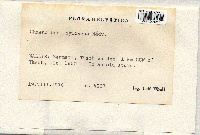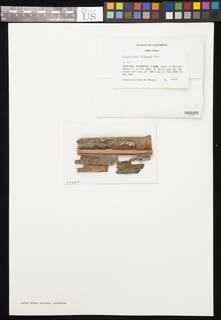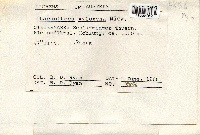
Consortium of Lichen Herbaria
- building a Global Consortium of Bryophytes and Lichens as keystones of cryptobiotic communities -
- Home
- Search
- Images
- Species Checklists
- US States: O-Z >
- US National Parks
- Central America
- South America
- US National Parks
- Southern Subpolar Region
|
|
|
|
Family: Coniocybaceae
[Chaenotheca xylogena Nádv.] |
Nash, T.H., Ryan, B.D., Gries, C., Bungartz, F., (eds.) 2004. Lichen Flora of the Greater Sonoran Desert Region. Vol 2. Thallus: immersed, sometimes revealed as a greenish or grayish tinge of the surface of the substrate photobiont: Stichococcus Apothecia: medium-sized to long, 0.9-1.5 mm high, 15-30 times as high as width of stalk stalk: 0.04-0.08 mm in diam., usually with a thick white pruina in upper part, lower part shining black capitulum: 0.14-0.26 mm in diam., obconical exciple: well developed, the lower side usually with a thick white pruina; the innermost, narrow part of exciple: continuous with the stalk, consisting of periclinally arranged hyphae continuing into the outer part of the stalk, the thick outer part of the exciple consists of swollen, anticlinally arranged hyphae; hypothecium: obconical, pale brown, with convex upper surface asci: formed in chains, short cylindrical or irregular, 8-13 x 2-3 µm with uniseriately or irregularly arranged spores ascospores: spherical, 3-4 µm in diam., smooth or with irregular, narrow cracks Anamorph: hyphomycetous conidia: one-celled, 2-3 x 1 µm Spot tests: thallus K-, C-, KC-, P- Secondary metabolites: none detected. Substrate and ecology: almost exclusively on wood, preferably on that of Picea, Pinus, Alnus and Quercus and rarely on bark of Picea, Larix and Quercus World distribution: widely distributed in the boreal and temperate zones of Europe, Asia, North America at 0-1800 m Sonoran distribution: California. Notes: Chaenotheca xyloxena is usually easily distinguished by its completely immersed thallus, and its slender apothecia, that are usually densely pruinose on the lower side of the capitulum and upper part of the stalk. It differs from C. trichialis in that in C. xyloxena the outer part of the exciple is thickened and consists of swollen anticlinal hyphae, resulting in a cushion-like appearance of the exciple. See also Tibell (2002). |
Powered by Symbiota





















